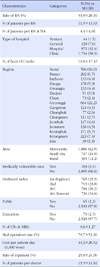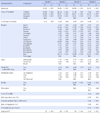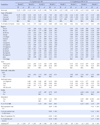Abstract
Purpose
This study was done to identify determinants of registered nurse (RN) skill mix and staffing level focused on hospital characteristics.
Methods
Data were obtained from health insurance claims data and hospital reporting system in the Health Insurance Review and Assessment Service (HIRA) for the year 2010. Data from 2,998 hospitals were analysed using t-test, ANOVA, Pearson correlation, and regression analysis.
Results
The RN skill mix and staffing level were positively related to hospital size and the percentage of inpatients to total patients. RN skill mix and staffing level were statistically different across regions. Including nursing aides (NA), however, there was no difference in staffing levels across regions. Medically vulnerable regions, bed operation rate, and the number of patients per doctor were also related to RN skill mix and staffing level.
Figures and Tables
Table 2
Distribution of Hospitals and Nurse Skill Mix and Staffing Level according to Hospital Characteristics

References
1. Aiken LH, Clarke SP, Sloane DM, Sochalski J, Silber JH. Hospital nurse staffing and patient mortality, nurse burnout, and job dissatisfaction. JAMA. 2002; 288:1987–1993. http://dx.doi.org/10.1001/jama.288.16.1987.
2. Blegen MA, Vaughn T, Vojir CP. Nurse staffing levels: Impact of organizational characteristics and registered nurse supply. Health Serv Res. 2008; 43:154–173. http://dx.doi.org/10.1111/j.1475-6773.2007.00749.x.
3. Bloom JR, Alexander JA, Nuchols BA. Nurse staffing patterns and hospital efficiency in the United States. Soc Sci Med. 1997; 44:147–155. http://dx.doi.org/10.1016/S0277-9536(96)00063-9.
4. Buerhaus PI, Donelan K, DesRoches C, Hess R. Registered nurses' perceptions of nurse staffing ratios and new hospital payment regulations. Nurs Econ. 2009; 27:372–376.
5. Cho SH, Yun SC. Bed-to-nurse ratios, provision of basic nursing care, and in-hospital and 30-day mortality among acute stroke patients admitted to an intensive care unit: Cross-sectional analysis of survey and administrative data. Int J Nurs Stud. 2009; 46:1092–1101. http://dx.doi.org/10.1016/j.ijnurstu.2009.02.001.
6. Cho SJ, Lee H, Oh JY, Kim JH. Inpatient outcomes by nurse staffing grade in Korea. Korean J Health Policy Adm. 2011; 21:195–212. http://dx.doi.org/10.4332/KJHPA.2011.21.2.195.
7. Feldstein PJ. Health care economics. 5th ed. New York: Delmar;1999.
8. Grumbach K, Ash M, Seago JA, Spetz J, Coffman J. Measuring shortages of hospital nurses: How do you know a hospital with a nursing shortage when you see one? Med Care Res Rev. 2001; 58:387–403. http://dx.doi.org/10.1177/107755870105800401.
9. Hodge MB, Romano PS, Harvey D, Samuels SJ, Olson VA, Sauve MJ, et al. Licensed caregiver characteristics and staffing in California acute care hospital units. J Nurs Adm. 2004; 34:125–133.
10. Kane RL, Shamliyan TA, Mueller C, Duval S, Wilt TJ. The association of registered nurse staffing levels and patient outcomes: Systematic review and meta-analysis. Med Care. 2007; 45:1195–1204.
11. Kim YM. Analysis of the factors that influence on the RN staffing level in the specified general hospitals. J Korean Acad Nurs Adm. 2000; 6:147–159.
12. Kim YM, Cho SH, Jun KJ, Go SK. The effect of institutional and market factors on nurse staffing in acute care hospitals. Korean J Health Policy Adm. 2007; 17:68–90.
13. Kim YM, Jun KJ, Cho SH. Factors related to nurse staffing levels in tertiary and general hospitals. J Korean Acad Nurs. 2005; 35:1493–1499.
14. Korean Small & Medium Hospital Association & Korean Health Industry Development Institute. Research on the actual condition of nurse staffing and nurse staffing grade. Hosp Line. 2008; 37:65–73.
15. Lankshear AJ, Sheldon TA, Maynard A. Nurse staffing and healthcare outcomes: A systematic review of the international research evidence. ANS Adv Nurs Sci. 2005; 28:163–174.
16. Lee S, Kim H. Development of hospital workforce structure for quality improvement. Seoul: Korea Public Service Union;2008.
17. Lin L, Liang BA. Addressing the nursing work environment to promote patient safety. Nurs Forum. 2007; 42:20–30. http://dx.doi.org/10.1111/j.1744-6198.2007.00062.x.
18. Mark BA, Salyer J, Wan T. Market, hospital, and nursing unit characteristics as predictors of nursing unit skill mix: A contextual analysis. J Nurs Adm. 2000; 30:552–560.
19. Needleman J. Is what's good for the patient good for the hospital? Aligning incentive and the business case for nursing. Policy Polit Nurs Pract. 2008; 9:80–87. http://dx.doi.org/10.1177/1527154408320047.
20. Newbold D. The production economics of nursing: A discussion paper. Int J Nurs Stud. 2008; 45:120–128. http://dx.doi.org/10.1016/j.ijnurstu.2007.01.007.
21. Numata Y, Schulzer M, Wal R, Globerman J, Semeniuk P, Balka E, et al. Nurse staffing levels and hospital mortality in critical care setting: Literature review and meta-analysis. J Adv Nurs. 2006; 55:435–448. http://dx.doi.org/10.1111/j.1365-2648.2006.03941.x.
22. Park SH. Analysis of direct nursing activity and patient outcomes related to graded fee of nursing management forinpatient. J Korean Acad Nurs. 2003; 33:122–129.
23. Seago JA, Spetz J, Mitchell S. Nurse staffing and hospital ownership in California. J Nurs Adm. 2004; 34:228–237.
24. You SJ, Choi Y, Kim H, Park B, Jang H, Park J. Development of a inpatient health care service model for job creation. Seoul: Korea Health Industry Development Institute;2006.




 PDF
PDF ePub
ePub Citation
Citation Print
Print






 XML Download
XML Download